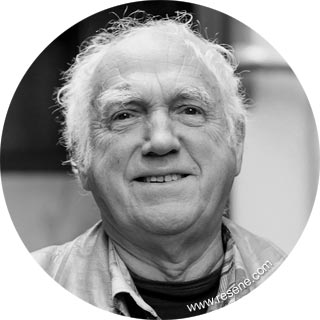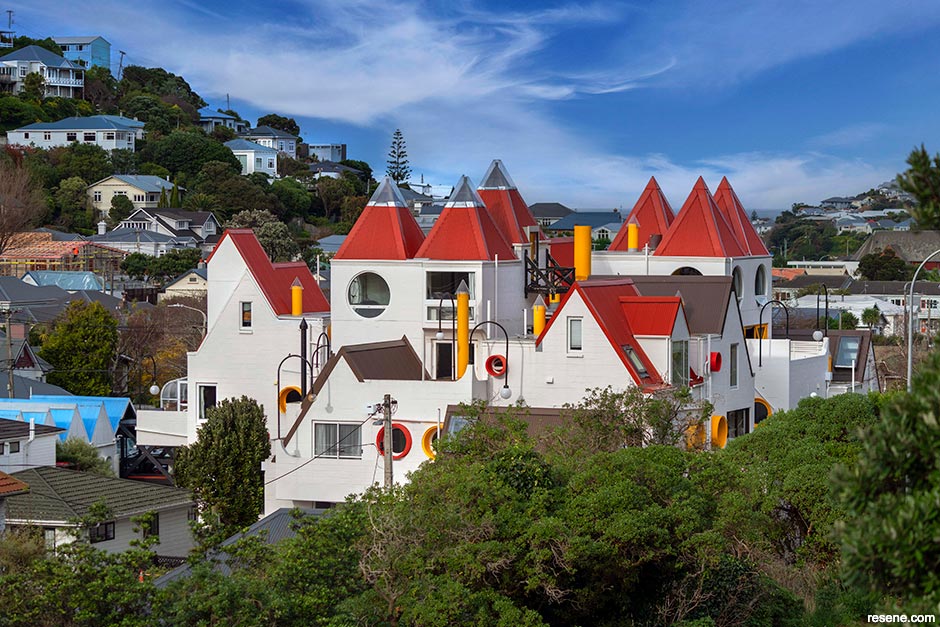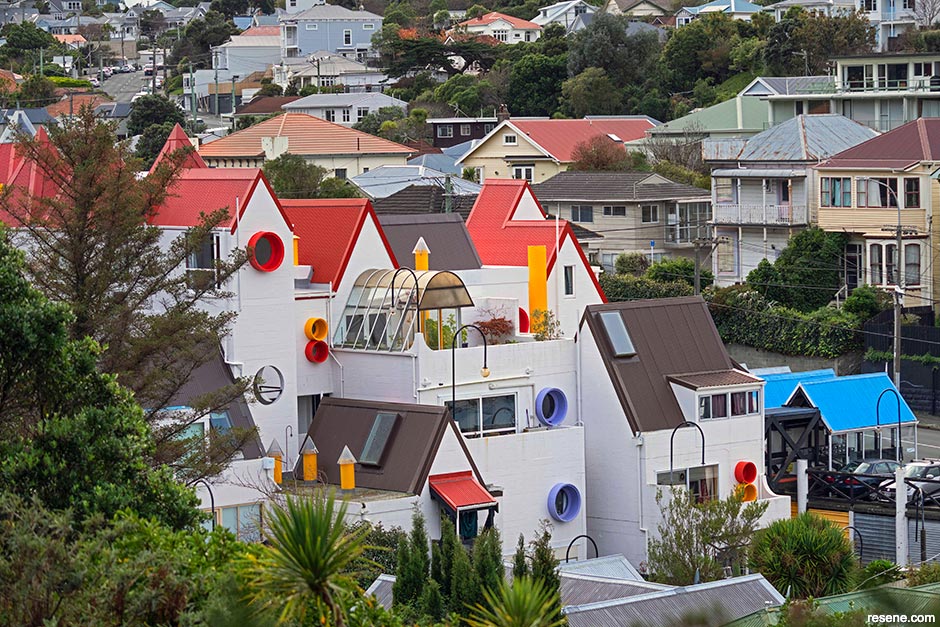From BlackWhite magazine - issue 07, over the rainbow
There are few architects in this world – and far fewer in our small corner of it – whose work is immediately identifiable, but the inimitable Roger Walker is one of them.

Roger Walker
As a recipient of some of the nation’s highest honours, including the 1998 Queen's Birthday Honours, being appointed an Officer of the New Zealand Order of Merit for services to architecture, the 2016 New Zealand Institute of Architects' Gold Medal, multiple Resene Total Colour Awards and many other accolades, his more than 50 years at the drafting table haven’t gone unnoticed.
In honour of his latest Resene Total Colour Award win, which recognised the reinstatement of the original exterior colour scheme to his 1974 Park Mews development in Haitaitai, we chatted with Roger about memorable projects, mentoring young designers and what he likes about Resene.
What was your impression of New Zealand architecture when you started your career, and what’s your impression of it today? Has it evolved more or less than you hoped it would over the course of your career, and is there anything in particular that you wish was different?
“I grew up in the quarter acre Kiwi dream: a Hamilton brick and tile suburban environment. My brother and I became obsessed with things that had wheels. A deep psychiatric analysis of this suggests a metaphor of escape. At the end of my high school training, I was doing science and languages and hadn’t made up my mind in which vocational direction to go.

“Growing up in Hamilton, there were no friends or family that had anything to do with architecture. I wanted to be a car designer. A nice vocational guidance lady said I would have to leave the country to do that. But she had good news; I could stay in New Zealand and design buildings instead.
“Beginning the training in Auckland University was an absolute revelation. Interesting architecture in New Zealand in the early 70s, when I began, was generated mainly in Christchurch by the likes of Miles Warren and Peter Beavan, who not only produced great consistent designs but debated their philosophies (which, by the way, were not the same) in front of us fortunate students.
“We were also tutored by brilliant minds and now famous architectural creatives such as Richard Toy and Vernon Brown. On reflection, it was a huge advantage to me to be innocently ignorant and with no architectural roots. It meant buildings like the Park Mews in Hataitai were my own ideas rather than by way of any influence or prevailing design method. The regulatory environment in those days did not impede creativity. I have obviously acquired a lot of knowledge over the last 50 years, but that early creativity is now compromised by profligate regulations and consenting difficulties. The Park Mews could not be built today. There is far too much ‘box ticking’.”
You have taken quite a number of graduate and intern architects under your wing over the years. What is your favourite part about mentoring budding architects and designers?
“I have employed many graduate students over the years. Sadly, there is a bit of a pattern where once they become registered architects, they leave to pursue their own careers. I did the same thing myself at Calder Fowler in Wellington, so I can’t blame them.

“My mentoring is just to encourage lateral thinking, question entrenched rules and regulations and introduce joy and surprise as fundamental requirements of design. Feedback I get from those I keep in contact with is all positive and hopefully I have been influential.”
You’ve said before that you plan to continue working until your very last day, but that until then, you want to spend more time travelling and cross some things off your ‘bucket list’. What have been some of your travel highlights?
“At the age of 80 years, I am now recalibrating my life. I enjoy travel and have four children and seven grandchildren in Australia. My first overseas trip was to Expo ‘70 in Japan. Japanese metabolism struck a chord with me – the honestly of the expression of vertical circulation, structure, services, claddings and finishes being composed as an orchestrated whole rather than ‘burying or hiding’ these elements is fundamental to where I am now at.
“I travel beyond Australia to experience cities and settlements rather than lie in the sun. The only Pacific island I have visited is Tonga, and that’s because we have a project there.”
In the last few years, you’ve been able to revisit the design of a couple of your past projects including incorporating an addition to your 1987 Wadestown house and giving your 1974 Park Mews development in Haitaitai a fresh colour scheme. What were those experiences like in terms of coming back to something decades later after you’ve inevitably evolved so much as a designer, and as a person?
“The 150 or so projects I have designed over the last 50 years are my ‘babies’. New owners often contact me. My office likes to do additions or alteration to these. The continuity is important, especially if the original design has been compromised by subsequent owners. I loved that the new (and younger) body corporate for Park Mews came back to me recently for the original colours, which they wanted to restore.
“Several of our old houses, including the well-known Des Britten house in Seatoun, have been similarly repainted.”
Are there any other past projects you would revisit if you had the opportunity? What changes or additions might you make if you were unencumbered by the constraints of budget, clients, neighbours or council?
“There are growth and change proposals for particular projects that I would dearly like to continue involvement with – particularly Whakatāne Airport (1974), which not only has enduring architecture, but it is the only Category 1 historic place by a living architect. We like receiving client instructions and responding to them.
“A quick story: Last year, a lady rang us after having heard that we were good at residential work. She accepted my invitation to visit the office. After 10 minutes of looking at photographs of completed houses and drawings of current projects, she said, ‘Mr Walker, do you design anything normal?’ That’s a good beginning for my book, as I was secretly flattered by being considered ‘different’.
“Big budgets are nice, of course, because restraint of finance does affect what you can build. But the quality of the design is always more important than the cost per square metre.”
What sort of process do you go through when you’re selecting colours for your projects? For example, how did you go about picking the original Resene colours for the Park Mews exterior – which I understand have been reinstated with the refresh?
“I think colour is fundamental to design. Billy Connolly looked me up when he drove past the Park Mews on one of his stand-up tours of New Zealand. He told me something I won’t forget: some people think that black and white are ‘colours’.
“Colour is expressive. As a child of Hamilton, to me, a standalone detached house sits in a garden. As the Park Mews does not have a garden, its circular porthole windows are abstracted flowers, in a more subdued main background. If we take the lessons of Mother Nature, large surface areas such as the ground and the sky are background. The smaller details in the overall environment, such as cars and people’s clothing, should be brighter to keep all in balance. Similarly, a fixed wall should be less colourful than the entry door (which also moves, giving added excitement).
“Colour also expresses function (through warmth, coolness, etc) so I would recommend avoiding red in hospitals.”
If you could wave a magic wand that would grant you more time in a day, what would you do with those extra hours?
“I would read, travel, meet more people and go to more movies.”
If you could go back in time to give young Roger one piece of advice, what would it be and why?
“Take care of yourself, don’t get stressed, stay calm and maintain a better work/life balance.”
What do you like about Resene?
“I like Resene for, in no particular order, their passion for their product, their amazing range of colours, their product innovation, their back-up for us architects and the fact that they are a New Zealand company.
“My favourite Resene colours are the ones that work together – warm and subdued background colours with more intense and colourful secondary elements. This philosophy applies to both interiors and exteriors.”
› To see more of Roger's portfolio, visit www.rogerwalker.co.nz.
Images: Grant Sheehan
This is a magazine created for the industry, by the industry and with the industry – and a publication like this is only possible because of New Zealand and Australia's remarkably talented and loyal Resene specifiers and users.
If you have a project finished in Resene paints, wood stains or coatings, whether it is strikingly colourful, beautifully tonal, a haven of natural stained and clear finishes, wonderfully unique or anything in between, we'd love to see it and have the opportunity to showcase it. Submit your projects online or email editor@blackwhitemag.com. You're welcome to share as many projects as you would like, whenever it suits. We look forward to seeing what you've been busy creating.
Earn CPD reading this magazine – If you're a specifier, earn ADNZ or NZRAB CPD points by reading BlackWhite magazine. Once you've read an issue request your CPD points via the CPD portal for ADNZ (for NZ architectural designers) or NZRAB (for NZ architects).